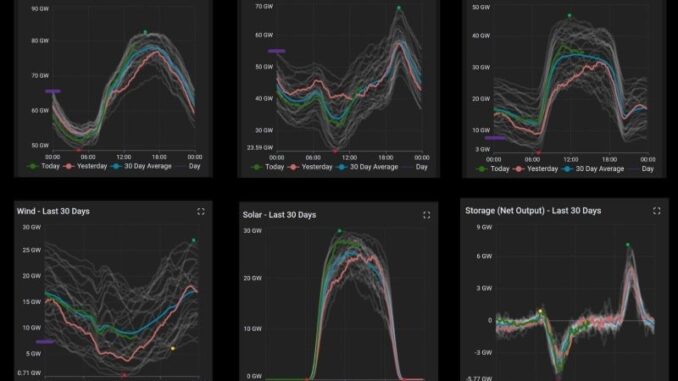
Doug Sheridan on LinkedIn writes:
Last month we came across the attached series of charts on the Grid Status app. They show continual generation on Ercot for the 30 days ending Aug 4—ie, the middle of the Texas summer.
We marked the demand peaks in each chart with green dots, and demand troughs with red dots. We then compared the same max and min values for the corresponding 30-day period in the very hot summer of 2023.
Here’s what we found…
Max total load during the 30-day window *fell* from 83.6 GW in 2023 to 82.5 GW in 2025, while the min total load rose from 46.3 GW to 49.0 GW. Max “net load” (ie, total load less renewables generation) was 68.4 GW in 2025, up from 67.0 GW in 2023.
ERCOT reported 85.2 GW of total dispatchable generation capacity in Aug 2025. A worst-case average summer utilization of 85% would mean 72.4 GW of available capacity to service the max net load of 68.4 GW, implying a worse-case coverage of 4 GW. This seems tight to us, but no doubt Ercot had other ways to deal if that worse-case scenario materialized.
Blackout risk on Ercot this summer was probably pretty low—but how might the same grid handle a Winter Storm Uri in 2025/26?
Let’s take a look…
Ercot believes peak demand on Ercot would have been roughly 77 GW during Uri (which hit in Feb 2021) had it not been for system constraints. Separate studies by the University of Texas and Texas A&M estimate it at 82 GW and 90 GW.
Typically, system demand in the winter peaks as Texans rise in the morning and return home in the evening. But storms like Uri are different. In these cases, folks mostly stay home, using appliances and lighting until they go to sleep around 10 PM.
During the winter, the sun sets in West Texas around 5:30 PM and rises as early as 6:30 AM. This leaves a 13-hr window in which overnight lows could drive net load to high levels—since solar energy has no chance to generate power during these hours. The hours between 8:30 PM and 10:30 PM (when folks are still awake) include the highest probability for net load peak.
Whatever hour the nightime peak happens, as it stands today Ercot would have about 85 GW of gross thermal dispatchable generation—in addition to whatever generation there was from 40 GW of gross wind capacity—to call upon during this window (we assume all batteries will have exhausted themselves by 8:30 PM).
If all thermal capacity operates at a winter worst-case of 80% utilization and wind at 5%, the system will need to shed at least 7 GW of load. If we assume the 90 GW of max demand per the UT study, at least 20 GW will need to be shed. Neither would be good.
Bottom Line: Isn’t it fair to ask why, almost five years on, Ercot’s still so vulnerable to another Uri despite the celebrated buildup of renewables on the system? After all, what’s the point of world-beating renewable installations if it means the Texas grid has enough generation to meet summer needs but must deal with capacity shortfalls in the winter?
Are we wrong to ask?
As for my staff and me, we will continually review our microgrid and make improvements every year. As CEOs, we need to examine the grid, stability, and behind-the-meter solutions. We cannot trust that the grid will hold, so we need to budget and plan for the worst while hoping for the best.
If you are a CEO and don’t have an understanding of how much power you need to run your business, call me. We have people we can connect you with.
Avoid Paying Taxes in 2025
Crude Oil, LNG, Jet Fuel price quote
ENB Top News
ENB
Energy Dashboard
ENB Podcast
ENB Substack






Be the first to comment